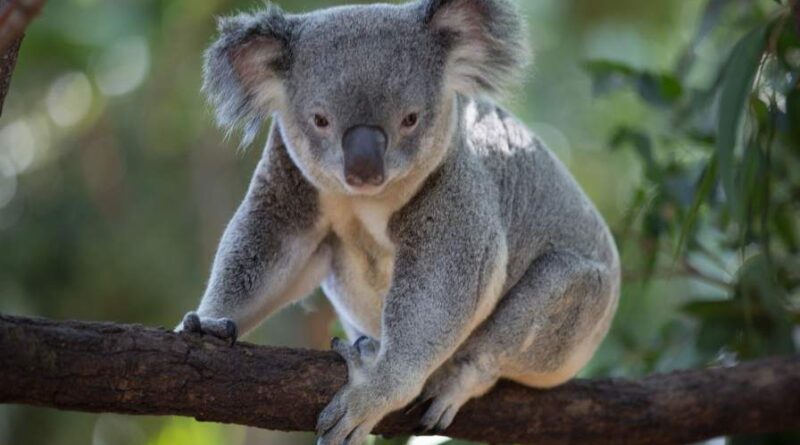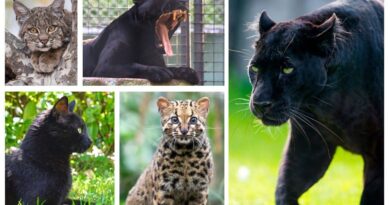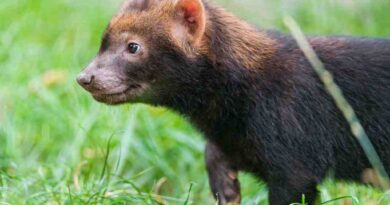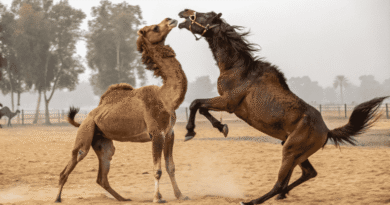KOALA
The Australian koala looks like it would make a great pet. It has soft, fluffy fur, a round body, and a big button nose. It looks cute right away because it has a flat face and looks soft. Everyone who meets one for the first time wants to hold it and pet it. But it is not at all a good pet for people, no matter how it looks.
It may look like a teddy bear come to life, but it is actually a very fragile animal that is hard to keep alive in a cage. This is because it only feeds the leaves of a small number of the many kinds of gum trees in Australia. If it doesn’t get the right food, it will soon curl up and die. It only eats oily leaves, which are not very nutritious and would kill most other animals. Because of this, it has very little energy and must spend most of its time sleeping. It sleeps at least eighteen out of every twenty-four hours, which is more than twice as much as people do. It sleeps all day and barely moves until nightfall. Then it starts munching on its tough, oily leaves and grinding them up as finely as it can to make them easier to digest. It keeps picking leaves and eating them, over and over again, until it has eaten about 500 grammes of leaves. Then it makes itself into a tree shape and goes back to sleep. That pretty much sums up what they do all day. She is funny, smart, curious, and athletic. It’s not any of these. In fact, it probably has the slowest and most boring life of any mammal we know of. As an animal, it wouldn’t be very interesting for long.
The only time koalas seem to be active is when they are trying to have babies. This is in Australia’s summer, which means from October to February. Then, at dusk, the males go searching for females among the trees. Both males and females have their own territories that they protect, and they tend to stay away from each other. But when it’s time to breed, the females let the males into their territory without fighting.
When these male koala are searching for males, they make a lot of noise. They cry all night long, which makes a terrible racket. People have said that the sound they make is like a growling bellow. When the males scare or worry the females, they may let out a long, wailing sound. Even though both males and females are adults by the age they are two years old, males usually can’t mate with females until they are four. This is because there are other, older males in the area who won’t let the new males get close to the females. Young males can only hope to find a mate when they are big and strong enough to defend themselves and stand their ground against the older ones. Koalas don’t pair up. The male and female have no reason to stay together after mating, since the female can easily raise her baby on her own and doesn’t need any help from the male. So, once the male has been to all of the nearby territories and mated with as many females as he can find, he can go back to his own tree and return his quiet life of sleeping and eating leaves.
The male’s territory is about three times as big as the female’s. This means that if a male wanders around the edge of his personal space, he will run into several females one after the other. Every time he does this, he quickly mates and moves on, giving himself the best chance of having more babies. Every year, only one baby is born to each female. When they are born, they are very small, just like the babies of many animals with fur. It only measures about 2 centimetres long. It weighs less than 0.5 grammes, which is the same as an office paper clip. If you hold a paper clip in your hand, you will get an idea of how small the koala baby really is.
When the baby is born, it crawls into a pouch on the front of the mother’s body. As soon as it starts to move around inside, it grabs one of the two long nipples there. When a koala gives birth to twins, it uses both of its nipples.
The pouch of a koala is strange because it faces backwards. The opening is not at the top, like a kangaroo, but at the bottom, facing the mother’s back legs. This seems like a very strange way for an animal that spends almost all of its time climbing around in the trees to protect its baby. With a sudden jerk or a fall, the baby, especially when it is bigger, could probably fall out of the opening of the pouch and onto the ground. Other pouch-living animals, like opossums, have the opening at the top, where you’d expect it to be. This makes the koala’s design a bit strange. Maybe it’s a very strong, stretched-out pouch that holds the baby close to the mother’s body and keeps it inside. We still don’t know the answer to this question.
After a few months, the baby may leave the pouch for a short time, but it quickly runs back to its safe “den” in the pouch. But by the time it is seven or eight months old, it is big enough to leave the pouch for the last time. It does not try to go back. Even so, it stays close to its mother and spends a lot of time riding on her back. This goes on until the end of the first year, when it finally leaves her alone and starts to take care of itself.
Its sharp, curved claws help it now as it looks around in the trees. It uses these to get up on branches and look for fresh leaves and places to rest. The way these claws are set up on its front feet is strange. Instead of having one thumb that reaches across four fingers like we do, it has two “thumbs” and only three “fingers5” on each hand. The two thumbs grab one side of a branch while the three fingers grab the other side, giving the animal a very strong grip for climbing. This also makes it hard for an enemy to pull a koala off a bush or tree once it has gripped it. Its hands are like strong clamps that hold the wood in place. Once, koalas were common all over Australia. However, in the last century, it became popular to wear animal furs, so millions of these small, harmless animals were killed for their skins.
On top of that, the new ways of farming that Europeans brought to Australia caused huge fires that destroyed large areas of forest. Some of the animals who lived there could hide in their burrows and stay safe. Others could run fast enough to get past the flames and get away. But the little koalas, who were always trying to stay in the trees, found stuck. As the fire moved through the treetops, it caught them and killed them right away. As if this wasn’t bad enough, koalas can also get sick. Many of them have been found to have serious illnesses, like a nasty fungus infection that kills them almost always. People can get this disease, so cuddling koalas in wildlife parks is a lot riskier than most people think. I realise
The koala was thought to be going extinct by the middle of this century. It looked like there was no way to help. Then, though, the people of Australia decided it was time to protect this very popular animal. They asked that the killing stop, and scientists started to look into the health problems of the animal. The koala wasn’t hurt. Today, their numbers are growing again, and many people can go see them in their natural environment and watch them sit in their favourite trees.
The koalas may not be able to avoid forest fires by living in the trees, but there is one big benefit to this way of life. It means that they never have to worry about killers who live on Earth and hunt them down. Dogs that settlers brought to Australia have killed a number of other animals with pouches that live on the ground. At least when it comes to this threat, koalas have little to worry about. The koala can’t drink from a stream or water hole very often because it rarely goes down to the ground. It only comes down to the ground to drink when it’s too hot to stay in the trees. At other times, it only comes down to move to a new tree or take a quick bite of soil or gravel, which it then swallows to help it digest. It moves clumsily on the ground and is quick to return to the security of the branches.
So, this amazing animal must get most of its water from the tough gum leaves it feeds most of the time in order to stay alive. Its name, “koala,” comes from this fact. It comes from the way native people used to pass a bowl of water around so everyone could drink. If someone in the group didn’t want a drink, he would say “koala,” which meant “no drink.”



